Table of contents
- Advice: secure thread Screws, nuts, threads – secure properly
- B split pin
- C lock washers
- D stop nuts or clamping nuts
- E washer or snap ring
- F safety wire
- Color marking
- More about technology
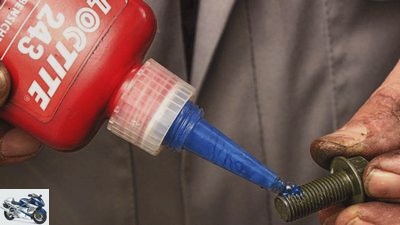
Schermer
counselor
workshop
Secure screws, nuts and threads
Advice: secure thread
Screws, nuts, threads – secure properly
In many cases it is not enough to tighten a screw or nut with the prescribed tightening torque. To really prevent them from coming loose while driving, extra safeguards are necessary. We show the most common methods.
Jorg Lohse, Franz Josef Schermer
02/03/2011
Many screw connections on motorcycles need additional safeguards against unintentional opening: Permanent engine vibrations can be so subtle that screw connections loosen themselves over the long term and the components then fall off. But vibrations and shaking loads also occur while driving, which can cause dangerous loosening of screw connections that were once tightened.
Basically, a distinction has to be made between screws and nuts that are secured as standard – their thread securing is therefore due to the design – and an additional or retrofitted securing of screws and nuts.
B split pin
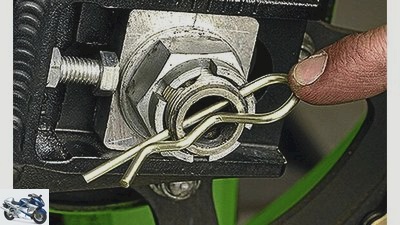
Schermer
Splint: The permanent splint is better than the one-way solution (in the picture).
A Liquid threadlocker
An almost invisible thread lock is gluing the threaded components with liquid thread locker: e.g. with Loctite “medium firm” holds almost every screw connection together reliably. Loctite is used for extremely stressed screw connections, e.g. the fastening screws of the rear brake disc “high Strength” required.
- Put a drop of Loctite on the thread of screws.
- Put a drop of Loctite into the thread of nuts.
Fuses with cotter pins are actually out – except for Kawasaki, nobody uses them anymore. But apparently the rear axle nut secured with a split pin is part of the technical philosophy of Kawasaki, otherwise you would not find it on almost every Kawa in every performance and price range. Securing with a split pin has one optical advantage above all: You can see at first glance whether the nut is tightened. If the cotter pin is missing, the workshop has probably forgotten to tighten it. Because the normal flexible split pin looks like a trampled worm after the first removal, it should be disposed of and a permanent split pin installed.
C lock washers
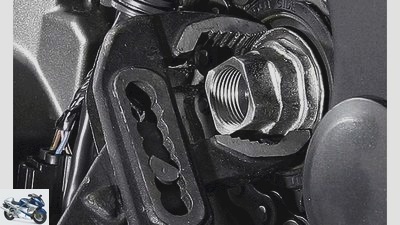
Schermer
Lock washer: is mainly found on the chain sprocket. Should always be renewed.
Structurally, z. B. securing the fastening screw (nut) with which the chain pinion is screwed onto the gearbox output shaft, in the case of the large central nut of the clutch basket or the screws of the rear chainring: In principle, after the screw (nut) has been tightened to the exact torque, the protruding part of the sheet metal is removed – Lock washer bent up against one or two surface (s) of the screw (nut) and placed tightly, for which it is best to use large pliers.
If such a screw connection is to be opened, the first thing to do is to separate the bent sheet metal tab from the contact surface with a chisel. Such a locking plate should be renewed with every assembly. You can only knock it flat with a small hammer and use it again if you bend it open extremely carefully and do not tear it or even break it.
D stop nuts or clamping nuts
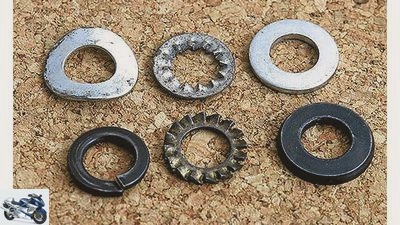
Schermer
Self-locking nuts: are available either in one-way format (center) or as a permanent solution (right).
Lock nuts are very elegant locking components, too “self-locking nuts” called. A plastic ring or several metal segments are used on one side of the nut. When tightened, the plastic ring deforms or the metal segments jam against the screw thread. A stop nut with a plastic ring should be used no more than twice; one with metal segments can be used as often as you like.
A clamping nut can be recognized by its approximately one-third deep slot. Do-it-yourself tip: saw a slot in the nut with a good hacksaw and squeeze it together in a vice.
Couplings sometimes have a nut installed, the edge of which is carefully driven into a groove in the shaft after tightening with a center punch. Before loosening such a nut, the deformation of the collar must be unlocked with a small chisel from the inside out.
E washer or snap ring
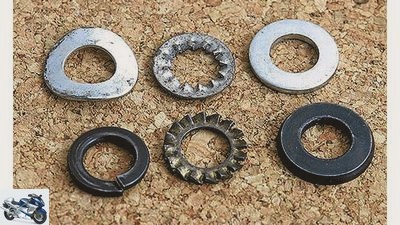
Schermer
Washers should distribute the surface pressure better. Snap rings (bottom left) are rarely used anymore.
The assembly of washers is often done wrong. Here is some basic information: A normal washer is installed if the surface pressure from the screw head (nut) should be better distributed over the workpiece. Today, nuts and bolts are widely used to which washers are already firmly attached.
Discs can also be equipped with spikes, they are called “Tooth lock washers”. These prongs dig very easily into the surface of the workpiece when the screw is tightened and, to a certain extent, prevent (unintentional) loosening. As with the washers, toothed washers can also be integrated into the screws or nuts. Because the prongs deform when tightened, such screws (nuts) should only be used once, at most twice.
“Snap rings” are wavy disks, the ends of which are open and have a point on each side. When tightening and loosening, they damage the surfaces of the screw (nut) and workpiece considerably, which is why they are rarely used today. On top of that, the standard for spring washers of this type has also expired. But hobbyists still like to use them, for example when adding a luggage rack, engine protection bar or fairing holder. In the case of sensitive surfaces (aluminum or plastic), the snap ring should be fitted with an additional washer.
F safety wire
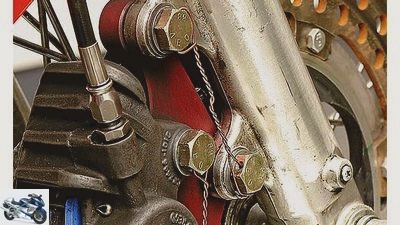
Schermer
Locking wires: the fine art of screw locking takes place above all in racing .
Some screws and nuts cannot be secured with Loctite because either adhesive protection is not possible (e.g. with the oil drain plug) or loosening is made more difficult due to the adhesive bond (wheel axle nut). Nevertheless, these screw connections should be secured like others (exhaust nuts, lock nut of the swing arm pivot pin, banjo bolts of oil lines).
When using a wire fuse, the following must be observed:
- Securing must always be carried out under tension in the direction of tight rotation.
- Use only high-quality steel wire (Ø 0.8 mm) as the safety wire and no soft flower binding wire, because it vibrates through!
- When securing the screw / nut to the frame, only use soft (annealed) copper wire (Ø 1 mm). If hard steel wire is used in such places, it first rubs through the paint and then works its way into the surface of the frame tube, creating a predetermined breaking point at which the frame can tear at some point.
The safety wire is twisted between the components to be secured. There are so-called for this “Safety wire pliers”. Anyone who has ever seen a professional mechanic handle such pliers professionally will know what “Aesthetics of the work” can mean: The sight of a precisely twisted safety wire with neatly folded ends has a very special attraction – and proves that the mechanic is competent.
Color marking
A simple form of optical screw locking is color marking, in which every screw (nut) that has been tightened with the prescribed torque is drawn with a color marking. This color marking is also a kind “final check”, when you are sure that this screw is tightened. Should a screw connection marked in this way open against expectations, this can be seen from the mutually twisted lines of color.
More about technology
PS knowledge: technology
- Motorcycle technology clearly explained on 97 pages (PDF)
- From starter to spark plug
- Simple teaching of physical principles
- Tips and tricks for practitioners
To the PDF for € 9.99
#image.jpg
Related articles
-
Torque customer: The right tightening torque for screws
Schermer counselor workshop Torque customer: The right tightening torque for screws Torque customer The correct tightening torque for screws Screw…
-
Schermer 8th pictures Schermer 1/8 The correct distance can be found in the manual. Use a lot of feeling when re-bending. Schermer 2/8 Above the spark of…
-
Rideet app: analyze, track, secure
Rideet accesories Navis, communication, apps Rideet app: analyze, track, secure Rideet app Analyze, track, secure The Rideet app is intended to make the…
-
Adjust the valve clearance on the BMW boxer
Schermer counselor workshop Adjust the valve clearance on the BMW boxer Screwdriver tip Adjust the valve clearance on the BMW boxer Thanks to the exposed…
-
Cheap tools: horror stories from the workshop
Schermer counselor workshop Cheap tools: horror stories from the workshop Horror stories from the workshop What good is cheap tools Order to the author…
-
motorcycles Data recording Data recording On a knife edge When MOTORRAD and the knives from 2D are involved, it’s only about one thing: data, data, data….
-
Clean the motorcycle with dry ice blasting
Bilski 25th pictures Bilski 1/25 Blasting with dry ice. Bilski 2/25 Bilski 3/25 Andreas Gschweng feeds the blasting machine with the CO2 pellets cooled…
-
Here’s how it works: All about chains
archive accesories Here’s how it works: All about chains That’s how it’s done Everything about chains Lighter than a cardan shaft, cheaper than a toothed…
-
Tension the chain correctly – it’s all about tension
mps photo studio counselor workshop Tension the chain correctly – it’s all about tension Tension the chain properly It’s all about the tension Is the…
-
Photos: Franz Josef Schermer counselor workshop Workshop guide Workshop guide – provisional Recognize botches on the motorcycle Recognize botches on the…